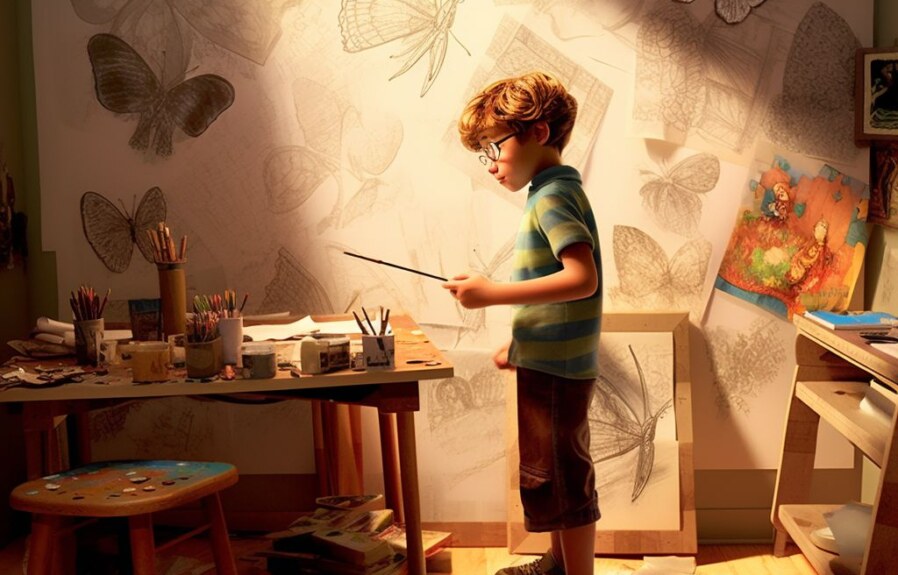Drawing is one of the most enriching hobbies a person can have. It allows you to express yourself creatively and share your emotions through art. Shading is one of the most crucial aspects of drawing that can bring depth, dimension, and life to a flat image. Proper shading can transform a simple sketch into a realistic masterpiece. However, shading can seem daunting for beginners, causing them to get discouraged and abandon their passion. Fear not, as this article will guide you through the basics of shading and equip you with the tools and techniques required to add stunning visual effects to your drawings.
1. Understanding the Basic Principles of Shading in Drawing
Shading is a crucial aspect of drawing that adds depth, dimension, and realism to your artwork. Knowing how to shade correctly is essential for any artist, regardless of their skill level. In this section, we will discuss the basic principles of shading in drawing.
Firstly, it is essential to understand that shading is the process of adding value or tonality to a drawing. This is achieved by using different techniques to create the illusion of light and shadow. Consistent, smooth shading is what gives the object its three-dimensional aspect and weight.
Secondly, the angle of light is critical when shading. The direction of the light source will determine where the shadows will fall and how they will appear on the object. It is essential to study how shadows fall on different objects in life or photo references.
Thirdly, consider the lightness and darkness (value) of your materials. Controlling the value of your shading tools takes time and practice. The value scale ranges from dark to light, with the white being the lightest and black being the darkest. The key is to find a balance of values to create the desired contrast and dimension in the drawing.
By practicing these basic principles, you are setting the foundation for creating effective and realistic shading. Remember to pay attention to the angle of light, the value of your materials, and create a smooth, consistent shading technique for your drawings to come to life.
2. Choosing the Right Supplies for Shading Drawings
Before starting to shade your drawings, it’s important to choose the right supplies that will help you achieve the desired effects. Here are some essentials you should consider when selecting your shading supplies.
1. Pencils: Pencils are the basic tool to start shading. You can use pencils of different grades, but generally a soft pencil with 2B, 4B, or 6B is recommended for shading. Hard pencils such as HB or H can be used for light shading and outlining.
2. Paper: Choosing the right type of paper plays a vital role in successful shading. A smooth textured paper, such as bristol board or drawing paper, is ideal for graphite pencils. A rough-textured paper such as toned paper is great for colored pencils and charcoal.
3. Erasers: For an error-free drawing, you’ll need the right type of eraser. A kneaded eraser will help remove shading without damaging the paper’s surface. A densely rubber eraser, on the other hand, can be used for precise and detailed erasing.
4. Blending Tools: Blending tools help to smoothen and distribute your shading evenly. Use a blending stump or tortillon on graphite drawings. For charcoal drawings, use a soft cotton ball or a chamois cloth.
Keep in mind that the quality of your supplies can affect the outcome of your shading. Investing in good quality supplies will significantly improve your work. In the next section, we’ll discuss how to perfect light and shadow techniques for shading.
3. Perfecting Light and Shadow Techniques in Shading
When it comes to creating realistic and three dimensional drawings, light and shadow play a crucial role. Perfecting your light and shadow techniques can truly take your artwork to the next level. Here are some tips for mastering the art of shading:
1. Observe Real Life: When trying to understand light and shadow, it’s important to observe how they interact in real life. Take a look at objects around you and observe how light hits them at different angles. This will help you understand how to create shadows that appear more realistic in your drawings.
2. Understand Source of Light: Knowing the direction and intensity of light source in your drawing will help you determine where to place the shadows. Make sure to visualize the light source and use it as a reference point when shading.
3. Practice With Different Values: Understanding value is crucial when it comes to shading. Practice creating different values with your shades, using a range from light to dark. This will help you understand how to make your shading appear more realistic.
4. Use Hatch Marks: Hatch marks are a common technique used in shading. Hatch marks are lines that are evenly spaced apart and used to create shadows on an object. Try experimenting with different patterns and angles to see the effects they have on your shading.
5. Use Blending Techniques: Blending techniques can help create a smooth transition between light and dark areas. Use your fingers, blending tools, or a soft pencil to blend together different shades.
By perfecting your light and shadow techniques, you can make your drawings appear more three-dimensional and realistic. Don’t be afraid to experiment with different techniques and tools to find what works best for you.
4. Creating Different Textures through Shading Techniques
Shading techniques can help create visual texture in drawings, making them appear more three-dimensional and lifelike. These techniques can help add depth and dimensionality to the images you create, making them more visually interesting and engaging. In this section, we’ll look at some ways to create different textures through shading techniques.
One way to create texture through shading is to use cross-hatching. This involves drawing overlapping lines at different angles, which can create a criss-crossing pattern on the page that gives the illusion of texture. You can vary the thickness and spacing of these lines to create an even greater sense of texture and depth.
Another technique is stippling, which involves creating small dots or points with your drawing tools to create texture. Depending on the size and spacing of the dots, you can create different effects, from a rough and gritty texture to a smoother, more uniform appearance. You can also blend these dots together to create a more subtle texture.
Finally, you can use shading techniques to create the illusion of different surfaces, such as smooth or rough materials. For example, you can use a gradual shading technique to create the appearance of a smooth, polished surface, or use more abrupt changes in shading to create the look of a rough, rugged surface.
By experimenting with these and other shading techniques, you can create a wide range of textures and effects in your drawings, helping to bring them to life and make them even more visually appealing.
5. Tips and Tricks to Improve Your Shading Skills
Shading is an essential aspect of drawing that can make or break your artwork. Whether you are a beginner or an experienced artist, there is always room for improvement when it comes to your shading skills. Here are some tips and tricks that can help you take your shading game to the next level.
Use Your Pencil to Create Different Shades
One of the most basic shading techniques involves using your pencil to create different shades. You can achieve this by applying varying amounts of pressure on your pencil while drawing. For example, pressing lightly on your pencil will produce a lighter shade while pressing harder will produce a darker shade. Additionally, you can use cross-hatching or stippling techniques to create texture in your shading.
Practice Blending Techniques
Blending is another crucial shading technique that can give your art a realistic look. You can blend your shading by using a blending stump or your finger to smooth out the lines and create a gradual transition between the different shades. It’s important to note that too much blending can leave your art looking flat and lifeless, so be mindful of the amount of blending you use.
Experiment with Different Shading Materials
While pencils are the most commonly used shading material, you can experiment with different materials to achieve a unique look. Charcoal, for example, can create a bold and dramatic effect, while colored pencils can add a pop of color to your shading. Watercolor pencils can create a soft, painterly look, while oil pastels can add a textured, almost 3D effect.
By using these tips and tricks, you can improve your shading skills and take your artwork to the next level. Remember, practice makes perfect, so be patient and keep experimenting until you find the techniques, materials, and styles that suit you best.
6. Utilizing Shading Techniques for Realistic Portraits
Shading is one of the essential tools that an artist uses to make a drawing look realistic. This technique brings out the 3-dimensional aspect of the subject and highlights its light and shadow points. While shading can be applied to any drawings, it is especially crucial when drawing portraits.
To create a realistic portrait, begin by building the basic foundation of the face using geometric shapes. These shapes act as guidelines to ensure that the proportion of the facial features are correct. Once you have the base shape, use a light pencil to add shading to the facial features. Remember to focus on the lighting source, creating highlights and shadow where necessary.
When adding shading to a portrait, take note of the different areas of the face that the light hits differently, such as the forehead, nose, cheeks, chin and neck. These areas are usually highlighted, while the opposite side of the face is usually shaded. Using a light source as reference when drawing is essential, as it helps to determine the direction and the intensity of the light.
Tip: If you are unsure and still learning to shade, try drawing from a photograph, and use it as a reference guide. Examine the areas of the face where the light hits, cross-reference with the image and adjust as necessary.
Remember to layer your shading by gradually building up the darkness, layer-by-layer, giving your portrait that depth and realism. Also, keep the pressure light as you add tone, as this will make it easier to make adjustments if necessary. Lastly, take your time and don’t rush your drawing. Rome was not built in a day, and the same can be said with creating realistic portraits. With patience and practice, you will be able to perfect this technique.
Summary
Creating realistic portraits with shading involves building a basic structure, focusing on lighting sources, and layering tones gradually. It also helps to follow a reference source and take your time when adding tone. With practice and patience, anyone can master this technique.
7. How to Avoid Common Mistakes in Shading Drawings
Avoiding common mistakes in shading can help improve the overall quality and realism of your drawings. Here are some tips to keep in mind:
1. Don’t Overwork the Pencil
One of the most common mistakes in shading is overworking the pencil. Too much pressure or excessive layering can create a muddy or smudged effect. To avoid this, use a light touch when shading and build up the layers gradually. It’s also important to choose the right pencil hardness for the job.
2. Pay Attention to Light Sources
Another common mistake is ignoring the direction and intensity of the light source. This can result in inconsistent shading and unrealistic shadows. Before shading, take a moment to observe the light source in your reference image and consider how it will affect the subject.
3. Use Reference Images
Drawing from imagination is a great skill, but it’s important to use reference images when shading to ensure accuracy and realism. This can help you avoid mistakes such as incorrect placement or proportion of shadows.
By keeping these tips in mind, you’ll be able to avoid common mistakes and create realistic, well-shaded drawings. Remember, practice makes perfect, so keep on shading!
People Also Ask
How do you shade a drawing for beginners?
Beginners can start by choosing a light source, identifying the areas of the drawing that will be in shadow, and using shading techniques to create a smooth transition from light to dark. They can also experiment with different types of pencils and shading tools.
What are the basic shading techniques?
The basic shading techniques include hatching, cross-hatching, stippling, and blending. Hatching involves drawing parallel lines, cross-hatching involves overlapping sets of parallel lines, stippling involves creating patterns of dots, and blending involves smoothing out rough lines and creating a smooth transition from light to dark.
What is the importance of shading in drawing?
Shading is important in drawing because it helps to create the illusion of depth, dimension, and texture. It can also add drama and interest to a drawing and help to direct the viewer’s eye.
How can shading improve a drawing?
Shading can improve a drawing by adding depth, dimension, and texture. It can also add visual interest and drama, and help to create a sense of realism or believability.
What are some tips for shading realistic drawings?
Some tips for shading realistic drawings include using a light source, studying objects or reference images to understand how light behaves, creating a smooth transition from light to dark, and paying attention to details such as highlights and shadows. It can also be helpful to work slowly and methodically, building up layers of shading gradually.
Conclusion
Shading is an essential skill for artists, as it can help to bring depth, dimension, and texture to a drawing. Beginners can start by choosing a light source and experimenting with basic shading techniques, while more advanced artists can focus on creating realistic shading through careful observation and attention to detail. With practice, anyone can learn to shade drawings effectively and create stunning works of art.



